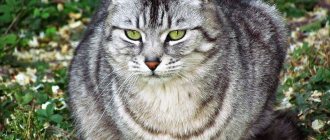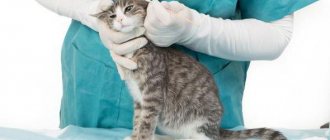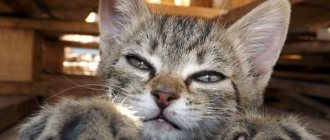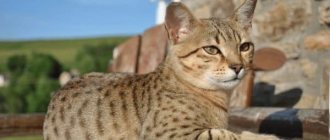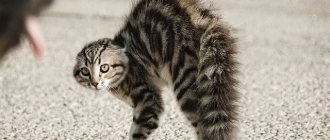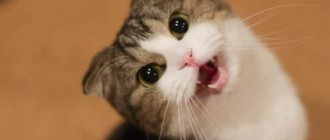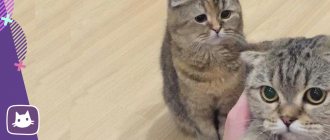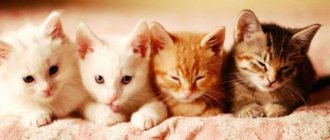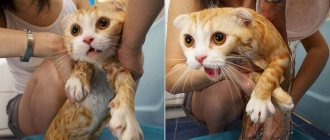The cat hits or rests its head against the wall. How should this be assessed?
Apparently, we will have to specify the title of the article for those who have not yet encountered such cat behavior. From the outside, everything looks quite strange: the cat approaches the wall, rests its head and sits for a long time, or even hits its head, as if trying to injure itself. It is necessary to distinguish such behavior from one of the forms of expression of love and affection of an animal in relation to its owners, when it comes up and affectionately rubs, at times, as if tapping its head against them.
Let’s say right away: if you notice such behavior, contact a veterinary clinic as soon as possible. Your pet may have severe damage to the central nervous system.
Causes. So, as we just said, most likely the matter is a lesion of the central nervous system, which, in turn, could arise due to: damage to the forebrain; toxic lead poisoning; metabolic disorders in which the body has too much or too little sodium (hyper- or hyponatremia); primary or secondary tumor; infectious lesions of the central nervous system; a previous head injury (for example, a cat might be hit by a car).
Unfortunately, the disease can affect any breed of animal, both male and female.
Visible symptoms of the disease. It is not for nothing that we put first place in the previous chapter precisely disturbances in the functioning of the brain: as a rule, cats begin to rest their heads against the wall precisely for this reason. The presence of serious problems is indicated by the following signs: disturbances in their psychomotor state, when cats randomly pace and spin around the rooms until sores or ulcers appear on the pads of their paws; general disturbances in normal cat behavior; epileptic seizures; reflex disorders; visual impairment; visible head or muzzle injuries.
How to diagnose the problem. First, the veterinarian will need a complete medical history. Secondly, the specialist examines the animal’s eyes. Finally, the following procedures may be required: blood tests; CT scan; magnetic resonance imaging; a urine test to help determine whether your cat suffers from metabolic disorders; blood test to determine the concentration of lead in the blood.
Treatment options. Treatment options depend on the severity of the animal's condition. In the most severe cases, you will probably be asked to leave the animal at the clinic. In a hospital setting, the veterinarian will calmly perform all procedures and tests and prescribe the correct treatment. If you were sent home, then be prepared for frequent follow-up visits to the clinic: the veterinarian will probably want to evaluate the effectiveness of the prescribed treatment over time. In addition, the animal will almost certainly require additional neurological examination, with the help of which you should find out whether complete social rehabilitation of your pet is possible.
Forecasts. Despite the severity of the disease, the prognosis for complete recovery may be favorable. But only if your veterinarian was able to correctly identify the root cause and treat (eliminate) it.
Almost every owner of a pet cat notices how their pet stares for a long time and carefully at the wall, as if he has found something very important and interesting for his eyes. Many people wonder why the cat is looking at the wall. Moreover, the wall to which the pet’s attentive gaze is directed is often ordinary, there is nothing special in it for a person, without bulges and depressions, without spots and dots. Often a wall can become a place of attraction for inquisitive cat eyes for a very long time.
Wall or void
The process when a cat looks at a wall or in a corner is reminiscent of meditation. A cat's brain is the size of a walnut. And a cat thinks no less than ours, and also draws conclusions. But the instincts of the pet take over everything; he will look at the wall, since any point on it serves as a hypothetically moving object. And if she also moves her paws, then she is potential prey.
Also, a cat and a cat can stare into space for a long time. What is emptiness for humans is not always the case for cats. A tiny ray of light can play its game in space, or some small object casts a shadow, and it trembles. Or a light breath of wind blows crumbs across the floor, creating the effect of a living creature.
Caprice or illness
For example, in the absence of the owner, the cat jumps and runs around the house. Cat Kevin McCallister “home alone” can fall off a shelf and land on his paws, fail to fit into a kitchen corner on sharp turns and hit a corner, or get a huge slap on the head from an overturned hard object. Finally, the same wall can cause illness. The cat ran and hit his head against the wall with all his might.
A person often notices something similar behind himself. When he has a headache, he wants to push it against the wall. A hard wall seems to be able to drown out the pain in my head. In the case of a cat, the wall seems to scream that the family pet needs medical attention.
There was a situation when a cat fell out of a high-rise building window. He survived, they picked him up, carried him into the apartment and released him, he crawled to the wall and rested his head against it. At a veterinarian's appointment, the cat's owners learned that their pet had a concussion.
VETERINARIAN CONSULTATION REQUIRED. INFORMATION FOR INFORMATION ONLY.
So, what do the positions in which a cat sleeps say?
Tangle: I feel good and calm
This is the most common sleeping position for cats. It means that the pet feels calm and safe. The ball helps minimize heat loss, and cats usually sleep in this position very comfortably. However, if you have not previously noticed that your pet likes to sleep curled up in a ball, and now every now and then you see him in this position, then you should pay more attention to your pet and check his health.
Covering your nose with your paw: get ready for the cold
On my back, stretched out with my stomach up: I'm happy!
A pose that opens the belly indicates maximum comfort for the cat. This means that nothing bothers him, he feels like a full-fledged owner and completely trusts all the people who are nearby.
Sitting with my paws tucked under my body: I’m not feeling well
If a cat tries to sleep in this position, something is apparently bothering him - he is rather not sleeping, but dozing, trying to be alert in case of danger. In addition, this pose may indicate health problems.
Everything seems to be clear with sleep. How do you understand a wide-awake kitty?
If a cat lightly butts you with its head, it means it is asking for affection or wants to thank you for something. Trampling in one place can be regarded as a real declaration of love. And if the cat impatiently “dances”, slightly lifting its front paws off the floor (some cats like to do this at the scratching post), then it is greeting someone very long-awaited. A quick lick of a front paw or nose signifies excitement and indecisiveness, while vertically raised ears signify curiosity.
BRIEF CAT DICTIONARY
Meowing is also a full-fledged language! It’s not for nothing that cats use it primarily to talk with people, and much less often to communicate with each other. With the help of meowing, a cat communicates when it is hungry, wants affection, or asks to leave the room or the house. But to communicate with their relatives, cats usually use other sounds - for example, hissing or snorting, when the cat is irritated or afraid, preparing to attack or defend itself.
Meow - greeting, request
Intermittent meowing - a response to a person’s call
Rumbling - dissatisfaction, warning of attack
A short cry - fear
Hissing - readiness for defense
Cats often take very funny poses, photos of which owners like to share with each other, without even suspecting that they give cause for concern, and not for a smile.
For example, on the Internet you can find many photographs of cats sitting with their faces to the wall and resting their foreheads on it.
The owners accompany them with humorous captions like “I’m offended” or “I can’t see you,” etc., without even suspecting that
such a pose indicates a serious disorder in the cat’s health!
In addition to the characteristic posture, signs of a concussion may include:
The set of symptoms depends on the severity of the injury and the location where it occurred.
It should be remembered that even a mild concussion causes quite extensive damage.
Brain tissue suffers not only at the site of impact, but also on the opposite side, because the brain, not fixed, but floating in the brain fluid inside the skull, is sharply deflected by inertia and hits the other wall of the skull.
Having made a diagnosis, doctors usually prescribe
vascular agents to prevent edema, as well as painkillers, antiemetics, sedatives, and, if necessary, medications to maintain the functioning of the lungs and heart.
In conclusion, let's say
that in addition to a concussion, the cause of headaches and dizziness, causing the cat to rest its head against the wall, can be acute toxic conditions, that is, poisoning, diseases of the nervous system, tumors of the brain or spinal cord and some other conditions.
Source
Own territory
Domestic cats are just as territorial as their larger wild counterparts. They make regular rounds of their properties, establishing their own boundaries through smells. Cats have special glands that secrete secretions, and they are located:
Most of them are on the animal’s head, therefore, by “butting” furniture and walls, they mark them with their smell in this way. The ritual must be repeated regularly, because the smell gradually disappears. Thus, cats living in a private house with access to the street can sometimes go on a spree for several days and the first thing they do upon returning is update their boundaries. Strangers' cats will immediately understand that they have entered someone else's territory, and the pet itself feels calmer and safer when it is surrounded by familiar smells.
Greeting other cats (and people)
Confrontation between cats is an affiliative behavior, meaning that it strengthens social bonds and is mutually beneficial for both animals. In this context, head butting is also known as allorubbbing, a general term for two animals of the same species rubbing against each other. When cats see a familiar cat or person approaching, they may let out a meow of greeting and often raise their tail vertically, hitting their head once in the immediate vicinity. This behavior can be traced back to interactions between kittens and mothers.
When two cats from a socially compatible group are separated and then reunited, the cats exhibit behaviors including greeting vocalizations, head butting, and allorubbbing.
Headbutting as a form of greeting also allows the cat to mark owners or other pets who were outside with the familiar scent of home and safety upon their return. Many cat owners can remember times when they interacted with other cats and dogs and came home to their cat sniffing them intently and almost immediately head-butting the area it had just sniffed.
Studies of the behavior of domestic cats have shown that genetically related cats are more prone to allorubism, so some veterinarians suggest that cats from the same family are less prone to conflict in the home.
© shutterstock
My owner
A claim for ownership also includes the situation when a cat rubs its muzzle against its owner. Fluffy pets treat their household members as part of their territory. The owner is the cat's property, so the smell of the cat must be present on it. This shows ownership of the individual and is a signal to other animals. That’s why pets so vigorously greet absent owners all day: after a long stay on the street, at guests and in public places, a person brings with them a whole bouquet of unfamiliar smells, and the cat urgently needs to restore balance.
Also, with a similar gesture, a cat can highlight an unfamiliar person, but for some reason he likes it. This helps the stranger adapt to the animal’s perception and study it better.
Other reasons
Experts who study domestic cats identify several more reasons for this cat behavior:
- Treatment. Many ancient civilizations considered cats to be sacred animals capable of healing. Some peoples still believe in this. This fact is confirmed by modern research: scientists from the Max Planck Institute for Human Development found that cats come to rub and purr to improve human well-being. This is how the pet tries to relieve pain, relieve stress and fatigue, and cheer up the owner.
- Removing negative energy. Followers of esoteric teachings believe in the psychic abilities of cats. The animal senses the bad energy of Sha, takes it upon itself and transfers it to the ground.
- Filial affection. Some animal psychologists believe that the reason for this behavior is the parent-child relationship between the kitten and the cat. Over time, the kittens begin to treat their owner as a caring mother, and with the ritual of “butting” they inform him of their good health and express gratitude for his care. Street kittens show their goodwill in this way and try to get affection and attention.
- Destroying the marks of other animals. If the owner was visiting, where there were other cats, whom he stroked and picked up, other people’s marks remain on the clothes. The pet is in a hurry to rid its person of foreign odors and marks him with his saliva, actively “butting” him.
Evidence of tender feelings
Of course, it is not only instincts that make animals rub their heads against humans. When at the same time the pet purrs loudly, covering its eyes, and buries its muzzle in the palms and face of the owner, it expresses its love and affection. In this way, the pet can express its joy that the owner returned home in the evening, or thank him after a delicious dinner. In any case, this indicates complete trust and mutual understanding between the cat and the person.
Another pet can also be recognized, even if it is a dog, the main thing is that the cat feels sympathy for it.
What does the gesture express and when does the cat use it?
Most people perceive this gesture as a sign of the cat's affection and good nature. And that's true. An animal will never behave this way in the absence of sympathy.
Sometimes in this way pets attract the attention of their owners. This is especially true for some breeds, such as the Ragdoll. They love to be the center of attention and cannot live without affection.
Another reason is unfamiliar smells. Touching surfaces saturated with unknown fluids, the animal, as it were, appropriates them for itself, mixes them with its own and other familiar odors.
Cats butt and rub their legs, begging for food, and, conversely, this behavior can be a manifestation of gratitude for a tasty dinner. In addition, it simply serves as a sign of good spirits.
Marking territory
Not only uncastrated males are capable of marking the boundaries of their possessions. The cat leaves invisible marks using glands located on its paws and face. To do this, the animal scratches surfaces or rubs its head on objects. A person will not smell such marks, unlike the “gifts” of sexually mature males. But cats are great at reading messages left by their relatives.
Mousers are owners. When faced with a new object in their territory, they strive to mark it. Because of this, the cat will rub its head on new furniture, household appliances, and clothes that it gains access to.
The owner is a constant component in the pet’s life. But the cat butts heads with the person every time he returns home. The owner brings with him many new smells. Their intensity depends on the pastime. A cat will be especially active if the owner:
The pet will strive to return the “native” smell to the person. To do this, the cat rubs its body against its owner and can sharpen its claws on pants.
Showing affection
Marking territory is not the only reason why cats butt heads with humans. Similar behavior is observed within the pack. Animals communicate using smells. Head butting is a way of expressing:
For these purposes, pets rub against each other. Behavior also helps create a "pack scent." By bringing its head closer to the face of another cat, the animal shows trust.
When communicating with a person, butting is a way to express feelings. A cat rubs its muzzle against its owner's head when it is happy or wants extra attention. At the same time, the animal purrs and can make characteristic kneading movements with its paws.
Cats butt differently
Animals, like people, have different personalities. One cat will butt so hard that it can injure the owner’s hand, the other will limit itself to light touches.
Marking territory and being recognized as a “pack member” is what it means when a cat butts its head. Such an expression of feelings is a sign of absolute trust. The cat can only pull its head or hit the person with force. Additionally, animals express affection:
So, the pet will climb onto your lap in the toilet, stretch out on a laptop or documents. If the cat receives enough attention during the day, the number of such manifestations of affection is reduced. But the result depends on the character and environment. Cats living with relatives or other pets receive enough communication while the owner is at work. But they also need to observe the ritual of greeting or evening affection.
It is important to remember that head butting is normal behavior. To varying degrees, it is common to all cats. Activity depends on the nature of the animal and its relationship to humans. There is no need to worry if the pet, despite its general friendliness, does not tend to butt heads. But, if a cat sits for a long time, resting its forehead against a wall or other hard surface, it is necessary to show it to a specialist. This posture is a sign of problems with the nervous system: from a concussion received during a game to the development of a tumor or other pathology.
When does your cat butt her head on her arm? Write in the comments.
Source
Territory marking
Cats butt their heads to mark objects, other cats, and people with a familiar scent, most commonly by rubbing their chin, forehead, and cheeks. In cat colonies, butting is not dependent on dominance. All cats in a group exhibit this behavior, and cats without the same scent may be kicked out of the group, meaning that the scent of the group is important in forming a cat's identity and allows cats to be reassured that another cat they encounter , are allowed to be within a certain geographical area.
© shutterstock
Indoor cats commonly head-butt a variety of objects around the house, with this behavior being on the harmless end of a continuum of behavior that can escalate into scratching and urine marking in some cats with behavioral problems.
In addition to marking familiar territory, head butting allows moving cats to retrace their steps using scent. This is important for wild cats searching for prey, and they also use markings to mark productive hunting grounds to which they can later return. After displaying aggression or an argument with another cat, cats will often mark nearby areas with their muzzle as a sign to unfamiliar cats that they are in the wrong territory.
The cat hits its head against the wall
Sometimes, for no apparent reason, your pet suddenly changes its daily behavior. The owner should be wary - this may be a sign of a disease that can only be diagnosed by a veterinarian. Before going to the clinic, you should take a closer look at the cat. Immediately go to the doctor if she refuses food and drink, reacts painfully to being touched or picked up, her breathing rhythm changes, her fur is tousled, does not fit correctly to her body, the cat takes unnatural positions when walking, sitting or lying down. All this is a sign of several diseases, including inflammatory processes of internal organs, poisoning, serious injuries (falling from a height, beating, etc.). Unnatural behavior and posture may not be associated with any disease. The fact is that the behavior of an animal is changeable, due to age, biological characteristics (readiness for fertilization, childbirth, etc.), ethology (the natural disposition and habits of the animal are determined), and the lifestyle of the owners themselves. Pets adapt to certain living conditions based on personal experience. Also, it has been scientifically proven that animals are susceptible to changes in the electromagnetic field of the Earth, therefore the behavior in which it rushes around the territory (house, yard, etc.), and then suddenly calms down, huddled somewhere (lasts about 24-48 hours) - indicates the likelihood of a natural disaster or earthquake within a radius of 100-150 km from the epicenter. The owner should be alarmed by the appearance of the symptoms listed at the beginning of the article. If a cat behaves unnaturally, takes positions that are unusual for it, first of all, this is a sign of illness or injury. Any slightest change in the behavior of a pet that is not inherent in its lifestyle in a healthy state is already a signal for immediate observation, a step towards qualified consultation.
Possible reasons for behavioral changes
The owner notices the fall (beating) of the animal as soon as possible. Symptoms: stops actively moving (even to the point of lying in one position for a long time), unable to approach food, water (or cannot take the correct position for eating); meows pitifully (especially if touched or lifted), lethargic, breathes heavily; signs of mechanical damage are visible on the body (blood, bumps, dislocations, limping, etc.). To avoid consequences from bruises and fractures, you should immediately show your cat to a veterinarian. Symptoms of tetanus: sudden short-lived (clonic) convulsions, when after each muscle contraction there is a relaxation; Coordination is impaired, it is difficult to open the jaw, etc. There may be tonic spasms: the muscles are in a state of contraction-relaxation for a long time, and the animal’s body seems to become stiff. Similar abnormal behavior also occurs with other infectious, viral, bacterial diseases (including toxicosis from the presence of helminths), or with pathology of systems in the cat’s body. Symptoms that occur with rabies: excessive affection of the pet is sharply replaced by aggression; can throw itself at inanimate objects (things, trees, fences); swallows inedible objects; aggressiveness towards other living beings (people, animals), increased salivation. The second stage of rabies is characterized by photophobia and hydrophobia (hides into darker places, is afraid to drink), excessive timidity, convulsive movements are observed (as if catching flies with its teeth), prolonged meowing (similar to howling or other sounds that are not characteristic of a cat). Inflammatory processes in the animal’s body and poisoning are the most difficult to diagnose for the owner. An exacerbation of the disease is easier to notice, since the pet’s behavior suddenly takes on an unnatural form: changes in temperature, attacks of pain are accompanied by an angry hissing (even growling), loud meowing, the cat takes unnatural positions in order to lie down and ease the pain in a certain area; Neuralgic attacks occur (convulsions, throwing the head back, etc.); nervousness (throwing around, frequent licking), the gaze becomes glassy, as if going nowhere. In the chronic course of the disease, the animal becomes apathetic, refuses to eat, stops caring for itself, refuses to go for walks, etc. Other reasons for unnatural behavior: changes in gait, reluctance to move, may indicate an accidental injury while walking. If a cat is constantly on its feet, refuses to lie down or sit down, it may have chest and stomach pain. There are a lot of reasons, ranging from bruises to intestinal obstruction. In any case, even if you know the reason for unnatural behavior or posture, consult a specialist. Your pet will be grateful for the speed of assistance provided for a quick recovery. Dear readers, this article is not a tutorial or instructions for self-treatment of cats. The animal needs the help of a specialist, because only in a clinical setting, based on research, using appropriate equipment, will the diagnosis be correctly established. Any delay or unqualified treatment can cost your pet’s life. Take care of your pet's health.
Source
10 Signs Your Cat is in Pain
The ability to quickly determine how severe the pain is and where it is located helps in diagnosing diseases and alleviating the suffering of the patient. Your cat cannot talk to you and verbally describe the location and level of pain. Your cat can't even point to a spot on its body like a small child. Therefore, it is very important to pay attention to physical signs of pain in your cat, as well as changes in behavior that may be a sign of pain. If you suspect your cat is in pain, please contact your veterinarian!
Here are 10 signs your cat may be in pain.
. This is not a comprehensive list, but simply a way to teach you how to identify behavioral abnormalities caused by pain.
1. The cat began to meow more, or the meowing became unusual.
Typically, almost all cats meow in one situation or another. But here you may notice that the meowing has become much more frequent and intense. You may also notice a change in the tone of the meow. It may become guttural, low-pitched, or more like a cry than a request or invitation to play. You should not ignore such changes in behavior and simply call the cat a “talker.” If this change in behavior occurred abruptly, then there must be a reason for this, and one of such reasons may be pain.
2. Intensive licking of one of the body parts.
Cats are famous for being very meticulous in their grooming. But if you notice that your cat is focusing her licking on a specific area of her body, this could be her attempt to relieve pain in that area. You may not notice her licking herself, but you may notice a bald spot on her coat or thinning fur. If your cat licks itself intensively, there is an increased chance of hairballs forming in the stomach, which can cause hair vomiting. Pay attention to this sign too.
3. Change in the appearance of the eyes.
You may see the third eyelid appear on your cat's eyes. This is a thin film that can completely cover the eyes or be partially visible. A cat in pain may begin to squint more often or keep its eyes completely closed.
4. Unsociability, attempt to hide.
If you notice your cat becoming more withdrawn or hiding more, this could be a sign of pain. If your cat is usually very sociable, then noticing her absence from regular evening gatherings is quite easy. But if the cat is timid, it will be more difficult to notice that she is hiding in an unusual place. Also, a sign of pain may be that a usually very affectionate and intrusive cat suddenly refuses to come to your lap or avoids petting. Now the cat may prefer to stay in darkened rooms and corners.
5. Shortness of breath or breathing with your tongue hanging out.
This is not a normal way for a cat to breathe, so do not ignore this sign. After intense physical activity, this sign is within normal limits, but not at rest!
7. Lack of appetite
This sign will be easier to notice if you feed your cat on a schedule rather than freely feeding it. This is just one of the reasons why I always recommend feeding cats on a schedule. If you have multiple cats, use separate bowls for each cat to control the amount of food the cats eat. If you simply put out one large bowl of food for all the cats, you will have no way of knowing who is eating and who is not until signs of weight loss or gain become physically obvious.
9. Changes in tray usage
This could be any change in physical habits, including using the litter box more often than usual or not using it. Your cat may often run into the litter box without any effect. She may sit in the litter box longer than usual. You may hear meowing while she is sitting in the litter box. Some cats will normally meow while in the litter box, so it is important to know and remember your cat's typical behavior. You may notice that she meows more, or her voice has changed and sounds more like a scream. You may notice urine or feces on the carpet or floor, as if the cat did not make it to the litter box. The cat may strain for a long time to pee or poop without any result. Also, the cat may suddenly begin to urinate in inappropriate places. Cats tend to associate the litter box itself with the pain they experience when trying to pee or poop. Notice the size and appearance of what's left in the tray. Changes in the volume, appearance, or smell of urine may indicate urinary tract disease, and this likely means your cat is in pain. Take a look at the poop before you simply scoop it up with a shovel and throw it down the toilet. Do they look different? Do they have slime on them? Does the color or smell seem a little different? Signs of constipation? Diarrhea? Changes in the quality of your cat's urine and feces may indicate illness, as well as pain. Spending time looking at your cat's poop isn't very pleasant, but it is an important way to monitor your cat's health.
10. The cat has become more affectionate
Some cats are very gentle, affectionate and even intrusive, while some only allow you to stroke their back once or even do not like physical affection at all. Again, you know your cat's personality and normal behavior best, so keep an eye out for changes. It's easy to just sit back and enjoy your unaffectionate cat's sudden desire to be on your lap all the time, but this could mean your cat is seeking comfort from pain.
Your cat's well-being is entirely up to you!
Many signs of pain can be subtle and easy to miss. For example, if you don't clean the litter box regularly, you'll miss the fact that your cat hasn't urinated or defecated in days. If your normally friendly cat becomes short-tempered, don't chalk it up to being in a bad mood, be wary! Sudden or uncharacteristic aggression is one of the most common signs of pain. Don't think that the cat has suddenly gone crazy! Run to the vet!
Cats are routine creatures, and changes in their behavior can be a sign that something is medically wrong. There is no need to wait for the weather to resolve the situation without your help if it concerns sudden changes in the cat’s behavior. It is possible that your cat is now experiencing excruciating pain and is trying to convey this to you by peeing past the tray, growling at an outstretched hand, or sitting “offended” under the bed for the second day.
Source
Showing affection
Free-ranging domestic cats have a matriarchal social structure with lineages from related females and their offspring. Affectionate interactions are common within these groups, in contrast to the often hostile exchanges that can occur after encounters with outsiders.
Group members commonly butt heads, and extensive allorubation is often observed between two genetically related cats. One study of cat behavior found that when two members of the same colony approached each other with their tails raised, mutual and simultaneous head rubbing occurred.
Showing affection through head butting begins when cats are very young and interacting with their mothers. Kittens that are handled by humans during this developmental period, between 2–7 weeks, typically exhibit the same affiliative behavior, including butting, towards humans as they do towards other cats in the group. This means that when a cat butts, rubs, or tries to groom humans, it considers them to be a bonded part of the group.
People can often take advantage of the importance of scent to cats. If there is conflict in the home after introducing a new pet, a technique called toweling can be used, where the same towel is used to rub all the cats in the same environment and create a uniform scent, potentially minimizing disruption. Cat owners should also encourage their cat's head butting and recognize it as an important part of the cat's communication system.
Posted by Megan Holmes Megan is a writer and documentarian specializing in scientific topics such as the environment, invasive species, sustainability, and nutrition. She holds a master's degree in Southern Studies from the University of Mississippi.
